The Toshiba OCZ RD400 (256GB, 512GB, 1TB) M.2 PCIe SSD Review
by Billy Tallis on May 25, 2016 8:02 AM ESTMixed Random Read/Write Performance
The mixed random I/O benchmark starts with a pure read test and gradually increases the proportion of writes, finishing with pure writes. The queue depth is 3 for the entire test and each subtest lasts for 3 minutes, for a total test duration of 18 minutes. As with the pure random write test, this test is restricted to a 16GB span of the drive, which is empty save for the 16GB test file.
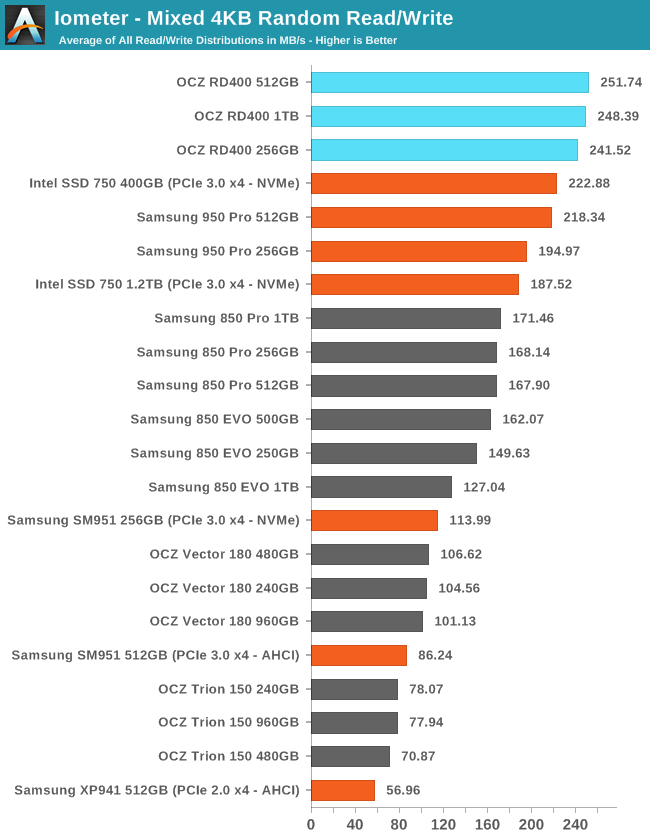
The RD400 sets new records for mixed random I/O performance with a substantial lead over the Intel 750 and Samsung 950 Pro.
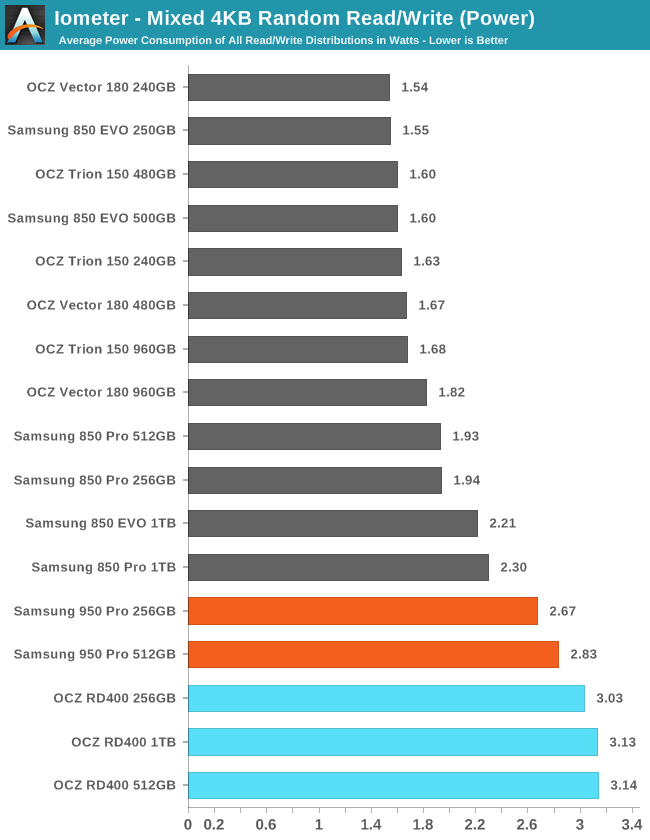
The RD400's power consumption is also record setting, but its efficiency is closer to normal for a PCIe SSD on account of the high power consumption yielding high performance.
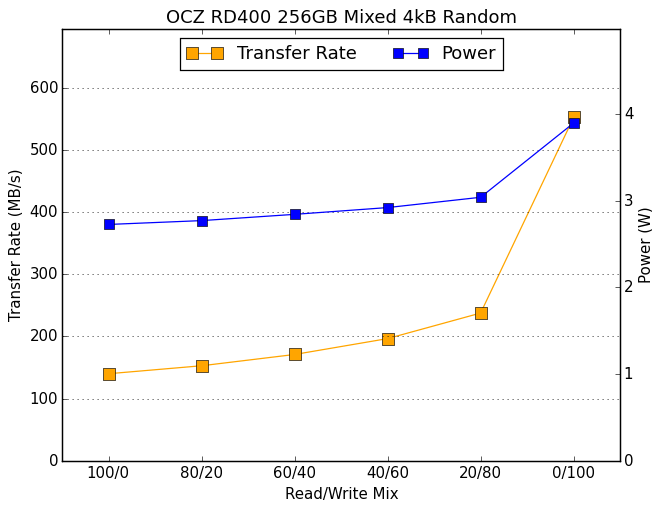 |
|||||||||
Most of the RD400's overall performance advantage is due to strong performance in the final phase of this test where the workload is 100% random writes. The 400GB Intel 750 has even higher random write speed, but performs lower on the other phases of this test.
Mixed Sequential Read/Write Performance
The mixed sequential access test covers the entire span of the drive and uses a queue depth of one. It starts with a pure read test and gradually increases the proportion of writes, finishing with pure writes. Each subtest lasts for 3 minutes, for a total test duration of 18 minutes. The drive is filled before the test starts.
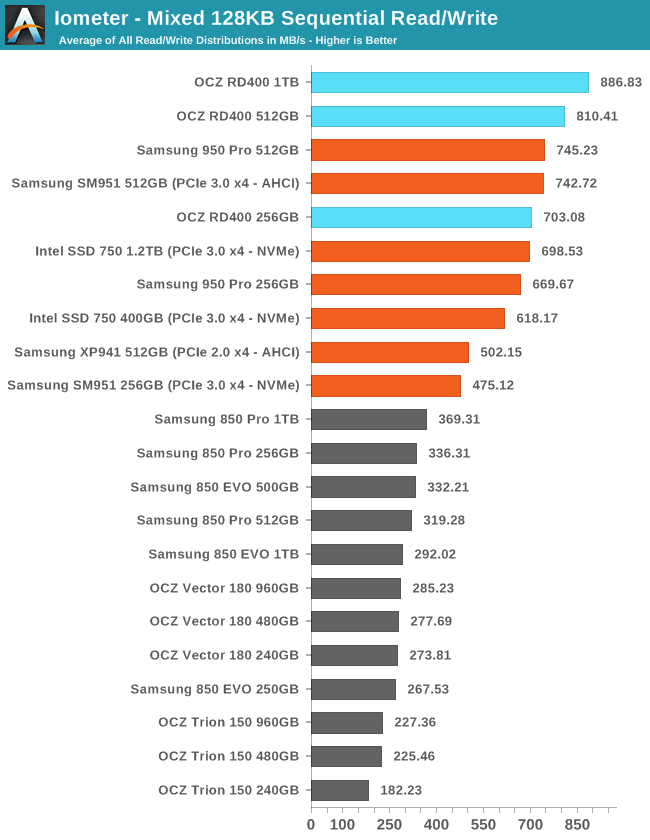
The RD400 handles a mixed sequential workload better than anything else and more than twice as fast as SATA drives.
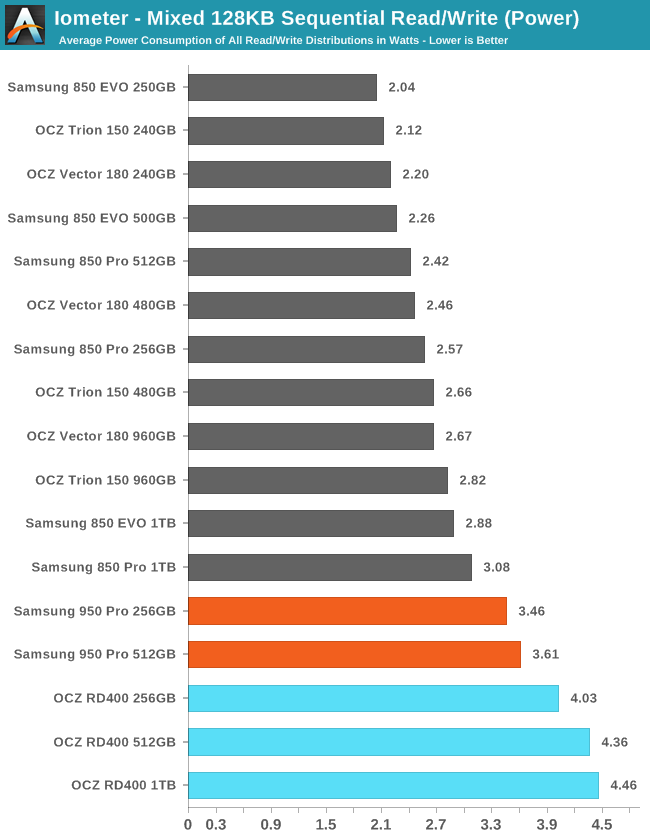
As usual, the RD400 needs plenty of power to deliver its high performance. The Samsung 950 Pro is a bit more efficient despite being slower.
 |
|||||||||
Performance across the mixed sequential test is usually a bathtub curve with the balanced mixes having the lowest performance. The RD400 bottoms out around the theoretical limit for SATA drives, which is substantially better worst-case performance than anything else. The 950 Pro has much better performance during the pure read start of the test but falls behind in the middle of the test and doesn't bounce back as much at the end.










40 Comments
View All Comments
tarqsharq - Wednesday, May 25, 2016 - link
Interesting article as always. I had been hoping for a larger price gap between this and the Samsung 950 Pro. At current prices, I think the choice is fairly obvious unless you need a 1TB SSD.Chaitanya - Wednesday, May 25, 2016 - link
You have a choice of Sandisk X400 as well if you want 1TB capacity in M.2 form factor.edzieba - Wednesday, May 25, 2016 - link
There's also the OEM version of the OCZ drive, the Toshiba XG3, which is also available in a 1TB m.2 SKU.Lord of the Bored - Thursday, May 26, 2016 - link
And who DOESN'T need a 1TB SSD?MrSpadge - Friday, May 27, 2016 - link
I think you're mixing up "want" and "need".DanNeely - Wednesday, May 25, 2016 - link
"Unlike most cheap adapter cards, the RD400's adapter draws power from the PCIe slot's 12V supply and converts it to the 3.3V required by the M.2 drive."PCIe slots provide 10W of 3.3V power directly. (I believe this was originally done to make converting legacy cards via a bridge chip easier.) Why would the card need to do any DC-DC conversion?
Byrn - Wednesday, May 25, 2016 - link
I'd assume that if they convert they can get cleaner 3.3V than if they use the feed through the PCIe slot, or that they can design in better resilience to sudden power demand changes...Basically, by converting I would have thought they can better fit the power supplied to the drive to the demands it makes.
digitalgriffin - Wednesday, May 25, 2016 - link
You can filter any volt feed with enough capacitors. But you lose power efficiency when you do.Alexvrb - Wednesday, May 25, 2016 - link
Yeah but they're filtering the power either way so converting from 12V -> 3.3V is less efficient than using 3.3V to start with. But getting back to what Byrn was saying... Byrn, they don't have a choice: This drive draws too much power to use the 3.3V supply.Look at idle power figures in this article. ~2.5W @ 12V. At 3.3V that would already be pushing it (right around 9W already). Under a load it's going to draw too much. So they had to use the 12V rail.
Wardrop - Wednesday, May 25, 2016 - link
2.5 watts is 2.5 watts. If it's a higher voltage, it's less amps, and vice versa. I think you've confused watts with amps?